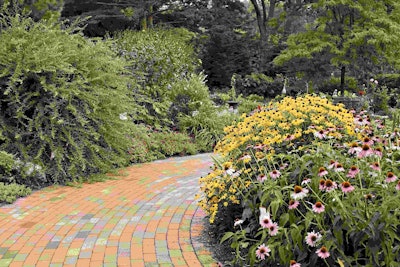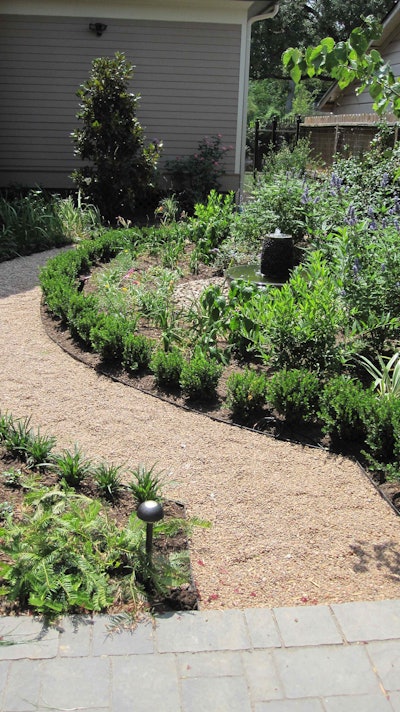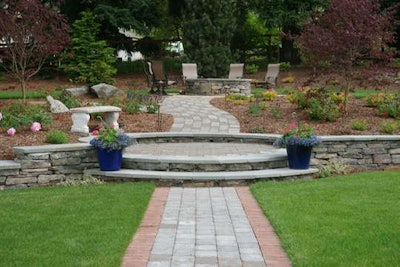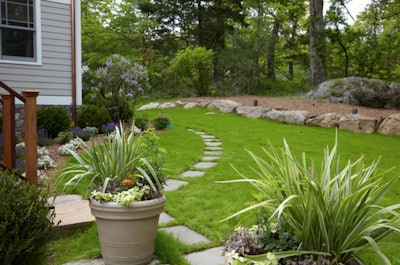 Some say that traveling is all about the journey and others say its the destination. How you design a path can answer this question.
Some say that traveling is all about the journey and others say its the destination. How you design a path can answer this question.The function of a path is travel – usually of the pedestrian, leisurely variety – but there are so many elements that go into its design, one can easily become overwhelmed by the creative possibilities.
With the immense design potential a path or walkway possesses, how does one start?
There are several different factors to take into consideration that can help you narrow the choices.
Cost
As it is the client who is paying for this hardscape masterpiece, money will be a concern for most homeowners, restricting what materials may be used on the job.
“A lot of what drives our design is the cost,” said Laurin Lindsey, co-owner and landscape designer of Ravenscourt Landscaping & Design in Houston, Texas. “Their budget is what limits what we do.”
If money is no object, this allows you to suggest more luxurious materials such as Pennsylvania bluestone.
Function
Knowing the purpose of the path can also aid the design process. If the walkway is meant to reach the front door, it makes more sense to use a straight path, as the purpose is to get there.
 A gravel path curves around a bird sanctuary installed by Ravenscourt Landscaping and Design
A gravel path curves around a bird sanctuary installed by Ravenscourt Landscaping and DesignPhoto: Ravenscourt Landscaping and Design
“A winding path is nice if you’re wanting to visit different aspects of the garden,” Lindsey said. “It slows you down so you can appreciate the various areas of the garden.”
Robert Welsch, founder and president of Westover Landscape Design Inc. in Tarrytown, New York, warns that landscapers should be careful when introducing curves.
“You want one that is similar to an elongated S or a musical note,” he said. “Ones that are too narrow can make you feel like you’re being corralled.”
This isn’t to say Welsch is against curving paths; in fact, he suggests using them if the house is very rectilinear. A curve can soften everything.
“It’s like you’re painting with brushstrokes, just on a ground surface instead,” Welsch said.
The function of the walkway also informs you what the proper width should be. If it is a major pathway with frequent foot traffic, a 3 foot-wide passage would not work, according to Debbie Brooks, owner of Creative Garden Spaces.
Material
The function, as well as the cost, can determine what materials are used in a project.
“If it’s a major walkway or pathway, I’m going to use a paver or concrete,” Brooks said. “If it’s an access path through the woods, I might use woodchips or crushed rock.”
 Straight paths direct the traveler to their immediate destination, which in this case is a patio.
Straight paths direct the traveler to their immediate destination, which in this case is a patio.Photo: Creative Garden Designs
Welsch prefers to take the style of the house and the neighborhood into account when selecting his materials.
“I look at genius loci, or the spirit of the place,” he said. “You don’t want to put discordant materials down. For a rustic home, you’d add fieldstone to go with that rustic look.”
Location also plays a role in choosing the best materials. Ravenscourt Landscaping prefers to use brick and gravel in their pathway projects. According to Lindsey, both have an Old World charm.
In addition to being less expensive, gravel is good at covering up the clay soil, while using mulch would result in a mess due to the area’s heavy rains.
While brick can work just fine in Texas, Brooks generally steers her clients away from using that material in the Pacific Northwest.
“We get a lot of rain and moss is hard to keep off the clay bricks,” Brooks said. “I suggest a brick paver that gives them the same look. They can still do herringbone or basketweave patterns, while it’s a lot more practical.”
Client’s needs
All three companies agreed that they generally drive the design process, but customer input always comes first.
If the client has a certain style or look in mind, that can also affect how many paths are curved or straight, so it will match the desired appearance.
Some customers’ requests have actually led to the more creative designs, like one project that Ravenscourt Landscaping did in which the walkway was actually disguised as dry riverbed because the homeowner wanted a subdued path.
 The stepping stone style path is growing in popularity, but some companies know it doesn’t fit their clients.
The stepping stone style path is growing in popularity, but some companies know it doesn’t fit their clients.Photo: David Davenport
Others might veto a material suggestion if it doesn’t fit their lifestyle. Brooks has suggested crushed rock in the past, but the customer knew their pets would scatter it everywhere and so they asked for another option.
Having a basic feel for what your clientele like can save some time at the drawing board. While placing flagstones spaced out with a groundcover growing in between is popular, Brooks prefers to stick to solid hardscaping since she knows it wouldn’t suit her market.
“A lot of my clients don’t have time for maintenance of the groundcover,” she said. “It looks great and is a really cool idea, but not really practical for my customers.”
Welsch has had many customers who save their inspiration in their Houzz idea books, and he’s always willing to work with their concepts.
“We love the collaborative process,” he said. “I always try to minimize the amount of material change so it works with the rest of the landscape.”











